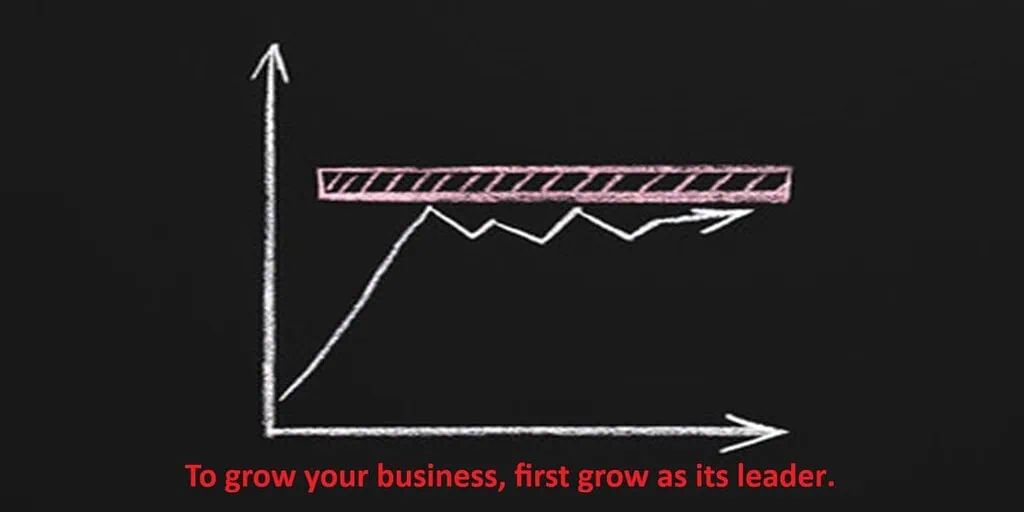Article Contents:
Business growth stagnation :
Many SME founders work tirelessly. Yet, their businesses reach a point where growth slows down.
Many small businesses don’t stagnate because the market lacks opportunity.
They stagnate because the founder’s way of leading has not evolved with the business.
Most small business founders begin their journey with unstoppable energy. They work long hours, chase customers, solve problems, and drive growth through sheer effort.
But as the business grows, something changes.
Sales stay steady, people stay busy, but the excitement of progress starts to fade.
It is not because the founder has lost interest. In fact, the opposite is true. The founder often remains so involved in daily operations that there is no time left for strategic thinking.
What worked beautifully in the early years starts creating limitations as the business matures.
Real Growth Is Beyond More Sales
Many founders believe that growth means doing more. More sales calls, more production, more customers.
But real growth is not about doing more. It is about doing differently.
It means creating systems and structures that keep the business running even when the founder is not personally involved in every decision.
Profitability plays a quiet but powerful role here. It does not automatically follow growth. It fuels it.
When revenue grows without margins, pressure builds. When profits are held too tightly without reinvestment, progress slows.
Sustainable growth happens only when both move together.
The Firefighting Trap
Ask any founder what their day looks like, and you will often hear the same pattern.
Customer issues in the morning, cash flow worries by noon, and people challenges by evening.
This cycle of constant problem-solving is what I call the firefighting trap.
The founder feels indispensable, but the business becomes dependent.
Every decision, big or small, flows through one person. Over time, growth gets limited not by market potential, but by the founder’s bandwidth.
The business keeps running, but it’s growth stagnation at the same level.
Shifting from Operator to Leader
Breaking this cycle starts with a mindset shift from running the business to building the business.
In my book Proven Path to Profitable Growth, I describe this as learning to think like a business owner, not just a doer.
It means stepping back from day-to-day firefighting and seeing the business as one connected system where customers, people, cash, and operations work in balance.
This does not mean being disconnected from the ground. It means building capable people, defining clear processes, and creating rhythm so the business can function independently.
When you do that, decisions become intentional, not reactive. That is when true growth begins.
Balancing Growth and Profitability
Every founder faces the same question. Should I chase growth or protect profits?
The answer lies in balance.
When you chase revenue at the cost of margins, the business becomes stressful.
When you protect profits without investing for the future, it becomes stagnant.
The best-run small businesses set growth targets that protect profitability. They monitor results closely and act quickly when growth begins to hurt margins.
Growth that depends on the founder is fragile. Growth supported by systems and capable teams is sustainable.
Developing Business Acumen
The turning point in any business comes when the founder develops business acumen.
Business acumen is not about financial jargon or corporate terms. It is about understanding how every part of your business connects and how your decisions impact the whole.
Many founders are great problem-solvers. But those who keep growing learn to step back and look for patterns rather than symptoms.
For instance, instead of resolving every customer complaint personally, they build a simple feedback mechanism that empowers their team to act early.
This is what thinking like a business leader means. You stop fixing problems one by one and start strengthening the system that prevents them.
Six Business Drivers That Shape Sustainable profitable Growth
From my consulting work with over 150 SMEs, I have seen that businesses that grow consistently manage six key drivers well.
Think of these as the pillars that carry your business forward.
If one weakens, progress slows. When all move together, momentum builds.
1. Customers and Products
Understand why customers choose you and what real problems you solve for them. The clearer your value, the stronger your growth foundation.
2. Employees
Growth happens when people grow. Place the right people in the right roles, give them clarity, and build trust. Overdependence on the founder then begins to fade.
3. Profitability
Look beyond top-line numbers. Know which products and customers create profit and which silently drain it.
4. Cash Flow
Cash gives confidence. Track it closely and keep a buffer so your decisions come from stability, not fear.
5. Operational Effectiveness
Growth is not about doing more. It is about doing better. Streamline processes, remove waste, and make every activity purposeful.
6. Growth
Stay alert to new opportunities. Whether it is new products, markets, or partnerships, consistent innovation keeps the business alive.
When these six drivers move in sync, the business feels lighter and growth feels natural again.
Habits That Help Founders Break growth Stagnation
Moving from an operational role to a leadership role does not happen overnight.
It begins with small, conscious habits that create gradual but lasting change.
Understand Your Numbers
Numbers never lie. Review your sales, margins, and cash flow regularly to see what the surface might hide.
Stay Curious and Keep Learning
Every discussion, customer visit, or book can teach something new. Curiosity keeps your thinking fresh.
Build Reflection Time
Take time to think on the business, not just work in it. Many solutions appear in quiet moments, not during meetings.
Seek Mentors and Peers
Surround yourself with people who ask the right questions. A new perspective can change your entire approach.
Make Data-Based Decisions
Intuition is useful, but data gives clarity. Decisions made with both insight and evidence rarely go wrong.
Experiment and Adapt
Try new methods, observe results, and refine your approach. Small experiments often create big breakthroughs.
These habits slowly shift the founder’s focus from control to empowerment, from activity to direction.
Summary & Reflection
Pause for a moment and ask yourself this.
If you stepped away from your business for a month, what would continue smoothly and what would struggle?
The answer will tell you whether you are building a business that can grow beyond you or one that depends completely on you.
Business Growth stagnation is not a failure. It is a message that your business has outgrown your current way of working.
When you step back, develop business acumen, and lead through systems instead of firefighting, you begin to unlock the next phase of growth.
Because in the end, your business can only grow as much as you grow as its leader.



